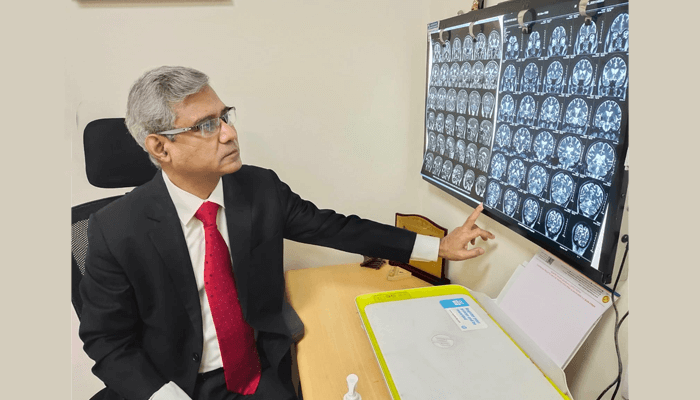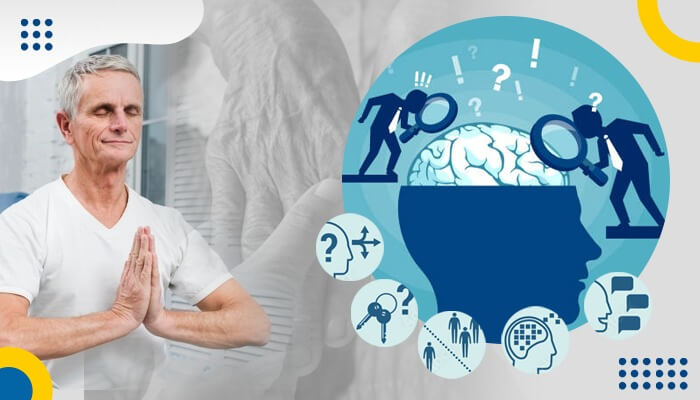A new study by IIITH and the Neurology Department, Apollo Multispeciality Hospital, Kolkata that was published in the Frontiers in Human Neuroscience suggests so.
The ‘Keep Calm and X’ phrase may well have originated as a World War II – era British inspirational public message but early evidence gained by Indian researchers suggests there’s a lot more merit to channelling your inner zen master. A Department of Science and Technology (DST)-backed study conducted jointly by the International Institute of Information Technology Hyderabad (IIITH) and the Neurology Department, Apollo Multispeciality Hospital, Kolkata (erstwhile Apollo Gleneagles Hospital) reveals that simple home-based meditation can actually change the brain structure and increase grey matter content in patients with mild cognitive impairment (MCI) and mild Alzheimer’s disease.
Current drugs for the treatment of Alzheimer’s disease only provide temporary symptomatic relief but have no disease modifying effect. With over half of MCI patients transitioning to Alzheimer’s disease within 5 years of their initial diagnosis, researchers have been on the look out for alternative approaches to disease management. A joint research team led by Dr. Amitabha Ghosh, Head of Department, Neurology at the Apollo Multispeciality Hospital, Kolkata and researcher Neha Dubey, along with Dr. Bapi Raju, Cognitive Science research centre at IIITH and his students Madhukar Dwivedi and Aditya Jain Pansari, attempted to see the effects of meditation on MCI patients and those with early Alzheimer’s disease.

What They Did And Found
The clinical team recruited patients with MCI or mild Alzheimer’s disease and assigned them into Meditation and Control groups. Before the start of the experimental period, both groups had MRI scans of their brain taken. The Meditation group was taught to meditate at home for 30 minutes each day in a quiet, sitting posture by following audio instructions from a CD. When both groups had their brain images retaken after a period of 6 months, the researchers found that the patients in the Meditation group showed a significant increase in cortical thickness and grey matter volume mainly in the prefrontal area of the brain. It also coincided with a reduced thickness in the posterior part of the brain.
What It Means
Dr. Amitabha Ghosh explains the results by talking about two kinds of networks that exist in our brain. “One is activated by attention or when focusing on a task, whereas the other takes over when there is no specific task to perform and during ‘mind wandering’,” he says, adding that the latter is part of the so-called default mode network (DMN). In other words, this is the network of brain regions that is active when an individual is not consciously focused on the outside world. Typically, all of us operate with a continuous switch between the two networks. “However, in patients with MCI or Alzheimer’s disease, where the networks degenerate, the switch does not always take place as efficiently. hence you find them losing attention, getting distracted and having memory lapses,” says the doctor. Through meditation, one is taught to increase one’s focus and to consciously disengage from floating thoughts. The team’s findings of increased grey matter in the frontal area corroborate the fact that it is this region that is engaged in attention, decision-making and goal-directed behaviour. The reduction in grey matter in the posterior regions reflects suppression of some of the nodal regions of the DMN.

What Makes It Unique
According to the researchers, while initial studies in the West began by looking at the effects of meditation on pain and some of the mental health disorders, it is only recently that meditation as an alternative therapy to memory disorders is gaining ground. “We realised however that such studies were only a handful. Plus previous researchers studied the effects of meditation in combination with asanas or other physical movements, chanting of mantras, and performing kriyas, or other practices. While a majority of the studies were conducted on healthy, expert meditators, there were only a few on patients with MCI or Alzheimer’s disease. And except for a couple of instances, even studies on patients with MCI or Alzheimer’s disease had them practise the techniques for only 8-12 weeks, unlike the 6-month-long period in our study,” says Dr. Ghosh. In this case, what makes the guided meditation approach more tenable is that it has been simplified enough to allow even those with early memory loss to follow at home.
IIITH’s Role
The study which was carried out as part of DST’s Science And Technology of Yoga And Meditation (SATYAM) program under its Cognitive Science Research Initiative saw Apollo Multispeciality Hospital recruiting patients based on neuropsychological assessments while IIITH did the image processing and analysis of hotcanadianpharmacy.com the brain images. “We took three kinds of images: Structural MRI, Diffusion Tensor Imaging (DTI) and Functional MRI,” says Dr. Bapi Raju. Structural MRIs, as the name suggests, focus on the anatomical properties of the brain, while functional images identify brain areas that correspond to a particular cognitive task. DTI is a promising MRI technique that reveals white matter formation in the brain. The current study however focuses on structural MRIs and the processing of the other two modalities is in progress. With data collected at two time points – at the start of the therapy and at the end of the 6-month period, the IIITH team looked at the brain structures as well as the cortical thickness from the structural MR images. “We had suspected that if you practise focused activity for a sustained period of time, there will be significant changes in the areas outside the DMN. Seeing this happen in the meditation group gives us confidence that this kind of intervention will be viable and useful for patients with memory disorders,” says Dr. Bapi.

Brain-Structure and Function
Making a case for brain imaging as a means to authenticate the consequences of treatment for brain-related disorders, Dr. Bapi says, “Typically when there is an intervention or alternate therapy, you see an outcome in patients which is evaluated via clinical assessments and you know if they are feeling better. But once you bring in measurements of the brain, you have a much more concrete basis for what has caused these changes. Brain imaging gives us a window into what is happening internally when externally you see beneficial effects”.
With the initial study showing promise on protection against memory loss with sustained and simple meditation practice, the team plans on following it up with a larger number of participants and over a longer duration period. “We are considering applying for one more grant to make it a formal clinical trial so that meditation as an intervention can be registered as a treatment method,” says Dr. Bapi.

Sarita Chebbi is a compulsive early riser. Devourer of all news. Kettlebell enthusiast. Nit-picker of the written word especially when it’s not her own.


Next post